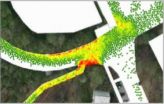(Press-News.org) Researchers at Winship Cancer Institute of Emory University have identified a new function for a gene that normally prevents the development of cancer.
Scientists had known that the gene, which encodes a protein called p14 ARF, works inside the cell to control proliferation and division. A team led by Erwin Van Meir, PhD, discovered that p14 ARF also regulates tumor-induced angiogenesis, the process by which growing cancers attract new blood vessels.
The findings, published in the Journal of Clinical Investigation, provide insight into how cancers form and progress, communicate with surrounding vascular cells and could guide the development of new therapies to fight tumors whose growth is driven by loss of p14 ARF.
Van Meir is professor of neurosurgery and hematology & medical oncology at Emory University School of Medicine and Winship Cancer Institute. Abdessamad Zerrouqi, PhD, research associate, is the first author of the paper.
Pinning down the new function for p14 ARF was a several-year detective investigation for Zerrouqi. The gene was a slippery target because growing cells in culture tend to lose or silence it, he says. P14 ARF is not turned on in most tissues of the body, but is activated in response to aberrant growth signals.
The gene encoding p14 ARF is mutated or silenced in many types of cancers, including most gliomas, the most common brain cancer in adults. People who inherit mutations affecting this gene develop "melanoma-astrocytoma syndrome," with increased occurrence of both types of tumors. ARF stands for "alternate reading frame" because the DNA sequence overlaps with another protein that is read out of step in comparison to ARF.
Previous research had linked the function of p14 ARF to another gene, p53, which is also frequently mutated in cancers. P53 is known as "guardian of the genome" because it shuts down cell division in response to DNA damage.
Zerrouqi says several clues pointed to a separate function for p14 ARF. P14 ARF is often lost when astrocytoma progresses to glioblastoma, a more deadly form of brain cancer.
"These tumors are bigger, more infiltrative and more vascularized," he says. "Yet p53 is usually lost at an early stage, before this transition takes place. This suggested that p14 ARF has a function that is independent of p53."
Zerrouqi could show that restoring p14 ARF in cells from a tumor that had lost it interfered with the tumor's ability to stimulate blood vessel growth. P14 ARF induces brain cancer cells to secrete a protein called TIMP3, which inhibits vascular cell migration, he found.
Zerrouqi and Van Meir's findings are applicable to brain cancers as well as several other cancer types. TIMP3 itself has been found to be silenced in brain, kidney, colon, breast and lung cancers, suggesting that it is an obstacle to their growth.
###The research was supported by the National Institutes of Health, the Pediatric Brain Tumor Foundation of the US, the American Brain Tumor Association, and the Southeastern Brain Tumor Foundation.
Zerrouqi, postdoc Beata Pyrzynska and Van Meir collaborated with Maria Febbraio, PhD, a researcher at the Cleveland Clinic to probe angiogenesis and Daniel J. Brat, MD, PhD, Emory professor of pathology and laboratory medicine, for pathological expertise.
Reference: A. Zerrouqi, B. Pyrzynska, M. Febbraio, D.J. Brat and E.G Van Meir. P14ARF inhibits human glioblastoma–induced angiogenesis by upregulating the expression of TIMP3 J. Clin. Invest (2012).
Writer: Quinn Eastman
New pathway found for regulation of blood vessel growth in cancer
2012-03-05
ELSE PRESS RELEASES FROM THIS DATE:
Simulator computes evacuation scenarios for major events
2012-03-05
VIDEO:
The new simulation program represents every individual in a ten-thousand crowd and shows color-coded crowd densities.
Click here for more information.
At twenty past five on Saturday evening in the German city of Kaiserslautern, 40,000 rival soccer fans pour out of the Fritz-Walter stadium after the final whistle has been blown on a league game. All of the fans are either heading to the parking lots or train stations. Even without any incidents, this is a difficult ...
March 2012 story tips
2012-03-05
ENERGY -- Designing tomorrow's water heater . . .
Consumers and the environment could ultimately be the beneficiaries of a high-efficiency CO2 heat pump water heater concept being researched by General Electric and Oak Ridge National Laboratory. Through a cooperative research and development agreement, GE and ORNL are designing a prototype residential water heater that will feature an energy factor of greater than 2.0 with a first hour rating of more than 50 gallons. If the design proves to be technically and economically viable, it could ultimately result in a commercial ...
Mobile mayhem
2012-03-05
First, the bad news: all across America, trucks and tractor-trailers are transporting industrial explosives on nearly every artery of the country's interstate and highway system. That's right, volatile explosives, including munitions, rocket motors, and dynamite, are moving at a high rate of speed down a roadway not too far from you.
Now, the good news: America's track record in transporting these materials is about as safe as they come. Very rarely, almost never in fact, are the potential dangers of these transports realized, largely due to instituted safeguards that ...
Research reveals first evidence of hunting by prehistoric Ohioans
2012-03-05
Cleveland . . . Cut marks found on Ice Age bones indicate that humans in Ohio hunted or scavenged animal meat earlier than previously known. Dr. Brian Redmond, curator of archaeology at The Cleveland Museum of Natural History, was lead author on research published in the Feb. 22, 2012 online issue of the journal World Archaeology.
Redmond and researchers analyzed 10 animal bones found in 1998 in the collections of the Firelands Historical Society Museum in Norwalk, Ohio. Found by society member and co-author Matthew Burr, the bones were from a Jefferson's Ground Sloth. ...
Solving mystery of how sulfa drugs kill bacteria yields 21st century drug development target
2012-03-05
MEMPHIS, Tenn. -- More than 70 years after the first sulfa drugs helped to revolutionize medical care and save millions of lives, St. Jude Children's Research Hospital scientists have determined at an atomic level the mechanism these medications use to kill bacteria. The discovery provides the basis for a new generation of antibiotics that would likely be harder for bacteria to resist and cause fewer side effects.
The work focused on sulfa drugs and their target enzyme, dihydropteroate synthase (DHPS). Most disease-causing microorganisms need DHPS to help make the molecule ...
Cardiovascular societies release heart valve replacement credentialing recommendations
2012-03-05
WASHINGTON, D.C. -- Four leading heart organizations representing cardiologists and cardiothoracic surgeons released initial recommendations today for creating and maintaining transcatheter aortic valve replacement (TAVR) programs. The recommendations are aimed at ensuring optimal care for patients with aortic stenosis, a form of valvular heart disease, as use of the new TAVR procedure grows.
Since the Food and Drug Administration (FDA) approval of TAVR in November 2011, interest in the procedure has quickly grown among cardiologists and cardiothoracic surgeons as ...
Does power cloud one's ability to make good decisions?
2012-03-05
Grave consequences can result from bad decisions made by people in leadership positions. Case in point: the 2009 Gulf of Mexico oil rig disaster. British Petroleum (BP) executives had downplayed potential risks associated with their oil well, claiming that it was virtually impossible that a major accident would ever occur.
That same oil rig exploded, killing 11 workers and causing a massive oil spill that's costing BP an estimated $100 billion.
For USC Marshall professor Nathanael Fast and his co-authors, the BP case represents only one example that illustrates a fundamental ...
Diabetes Research Institute develops oxygen-generating biomaterial
2012-03-05
Miami, FL – March 1, 2012 -- Scientists at the Diabetes Research Institute have developed a revolutionary technique to provide critical oxygen for maintaining the survival of insulin-producing cells. This is the first time that scientists have been able to successfully deliver oxygen locally to beta cells using a biomaterial. The results of the study, which represents a major step toward the goal of developing an alternative site to house insulin-producing cells, were just published in the prestigious journal Proceedings of the National Academy of Sciences (PNAS).
One ...
New study links dust to increased glacier melting, ocean productivity
2012-03-05
MIAMI -- A University of Miami (UM) Rosenstiel School of Marine and Atmospheric Science-led study shows a link between large dust storms on Iceland and glacial melting. The dust is both accelerating glacial melting and contributing important nutrients to the surrounding North Atlantic Ocean. The results provide new insights on the role of dust in climate change and high-latitude ocean ecosystems.
UM Rosenstiel School Professor Joseph M. Prospero and colleagues Joanna E. Bullard and Richard Hodgkins (Loughborough University, U.K.) analyzed six years of dust concentrations ...
Barleyfields Records Makes Debut With "After All" On Leap Day
2012-03-05
The St Louis, MO based musical group Barley Station is proud to announce the release of their first album, "After All," under their new label: Barleyfields Records. The album will be available via major digital outlets such as iTunes, Amazon, Verizon, Napster, etc. Physical copies will be made available via CDBaby.com and through CD Baby's physical distribution partners. The album contains the critcally favored single "I Found You," which the Music Dish Journal described as "Rootsy alternative country at its best: catchy guitar riffs, driving rhythms, ...

